Analyzing Stereotypes, Organizational Behavior, and Workplace Dynamics
VerifiedAdded on 2023/06/13
|9
|2278
|350
Essay
AI Summary
This essay examines the presence and impact of stereotypes in the workplace, exploring both the merits and demerits of such perceptions. It delves into how stereotypes can affect organizational behavior, influencing group dynamics and individual performance. The analysis includes a critical review of organizational behavior theories, such as classical, behavioral, and contingency structures, and their effectiveness in managing workplace issues and mitigating negative effects of stereotypes. Furthermore, the essay discusses the influence of ethical, social, and cultural factors on organizational behavior, highlighting challenges related to differing ethical norms, social issues like discrimination, and cultural differences. Finally, it proposes strategies for improving organizational behavior, including ethical training, cultural awareness, and corporate social responsibility initiatives, to foster a positive and productive work environment. Desklib provides access to this and other solved assignments to support student learning.
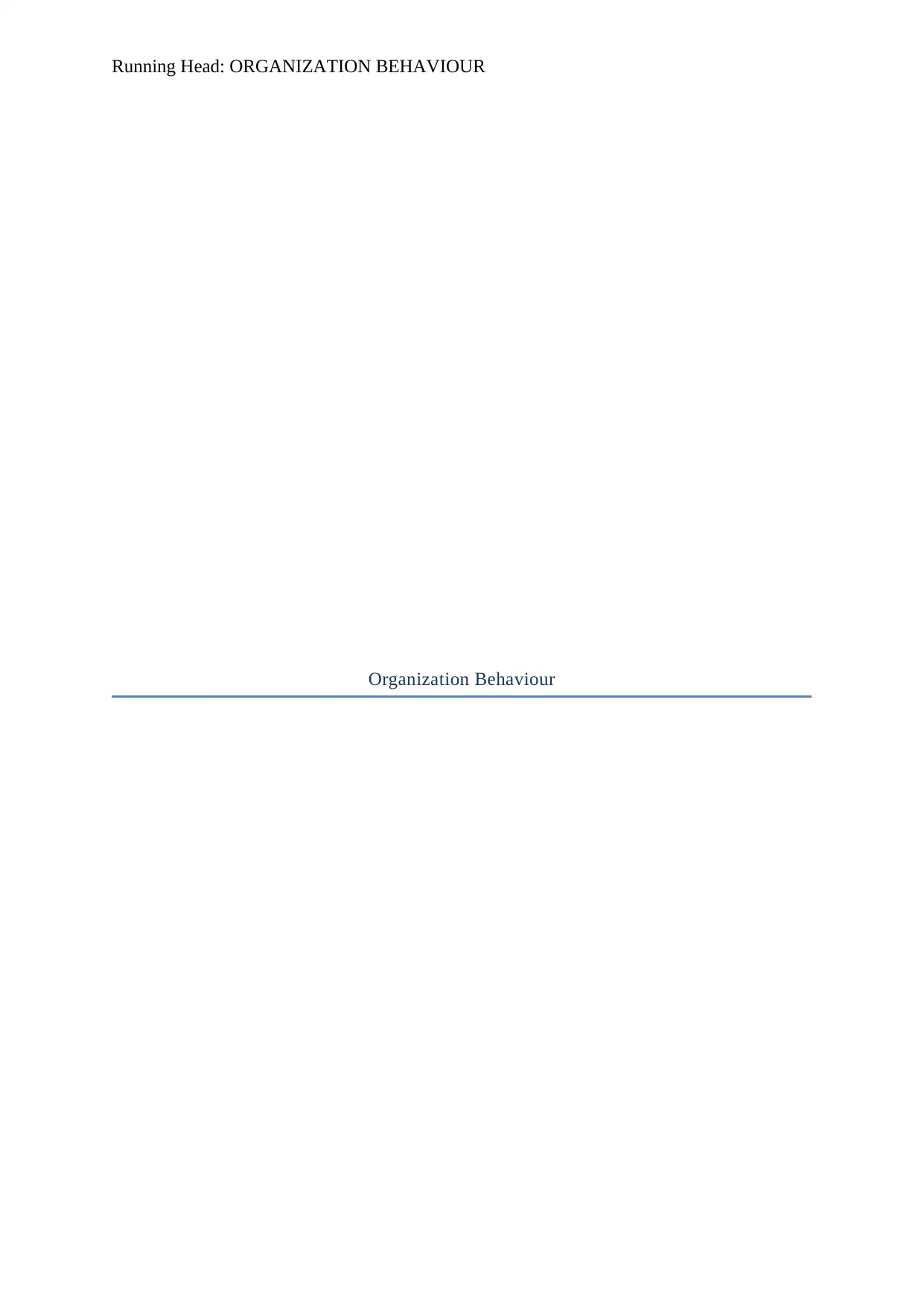
Running Head: ORGANIZATION BEHAVIOUR
Organization Behaviour
Organization Behaviour
Paraphrase This Document
Need a fresh take? Get an instant paraphrase of this document with our AI Paraphraser
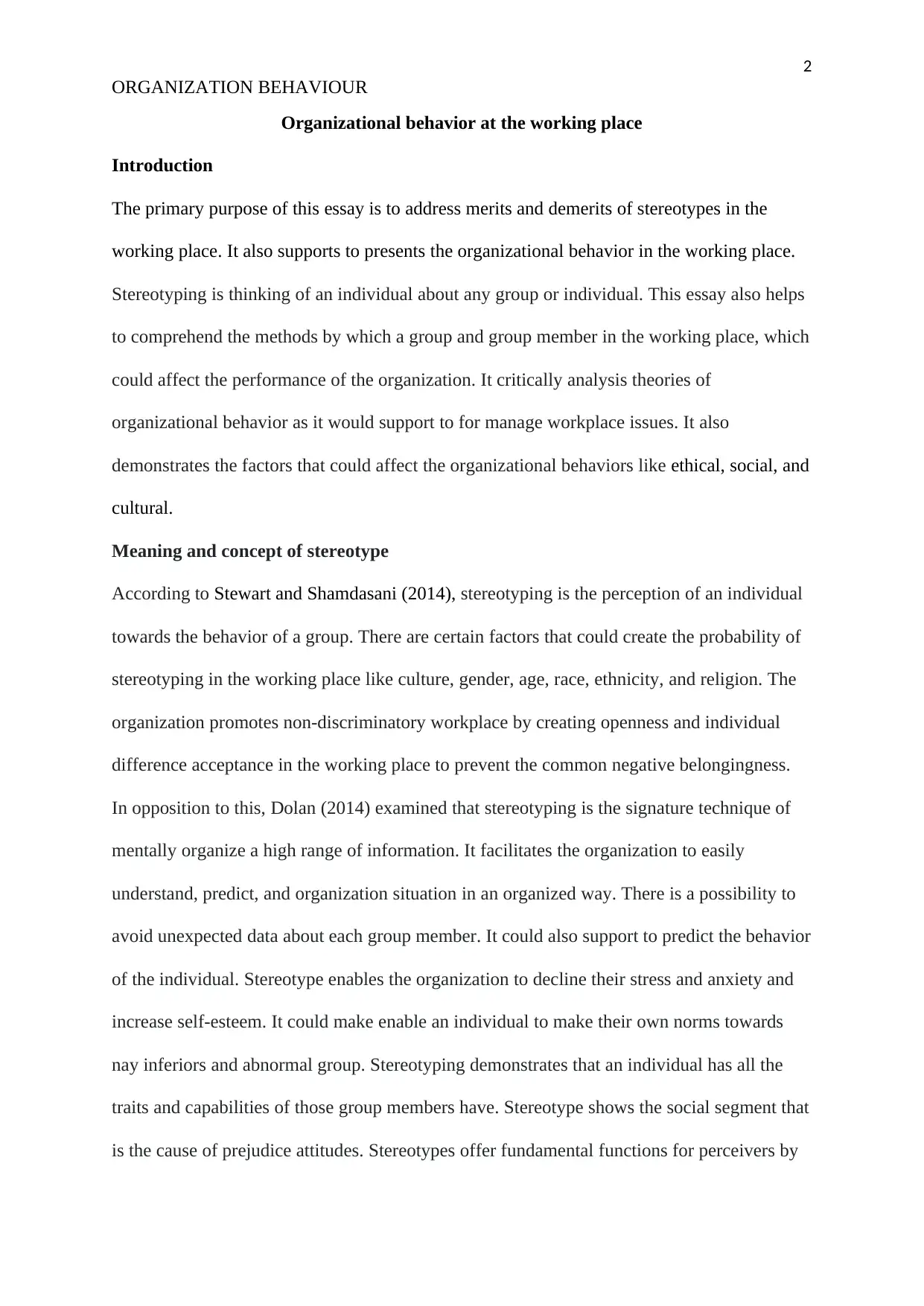
2
ORGANIZATION BEHAVIOUR
Organizational behavior at the working place
Introduction
The primary purpose of this essay is to address merits and demerits of stereotypes in the
working place. It also supports to presents the organizational behavior in the working place.
Stereotyping is thinking of an individual about any group or individual. This essay also helps
to comprehend the methods by which a group and group member in the working place, which
could affect the performance of the organization. It critically analysis theories of
organizational behavior as it would support to for manage workplace issues. It also
demonstrates the factors that could affect the organizational behaviors like ethical, social, and
cultural.
Meaning and concept of stereotype
According to Stewart and Shamdasani (2014), stereotyping is the perception of an individual
towards the behavior of a group. There are certain factors that could create the probability of
stereotyping in the working place like culture, gender, age, race, ethnicity, and religion. The
organization promotes non-discriminatory workplace by creating openness and individual
difference acceptance in the working place to prevent the common negative belongingness.
In opposition to this, Dolan (2014) examined that stereotyping is the signature technique of
mentally organize a high range of information. It facilitates the organization to easily
understand, predict, and organization situation in an organized way. There is a possibility to
avoid unexpected data about each group member. It could also support to predict the behavior
of the individual. Stereotype enables the organization to decline their stress and anxiety and
increase self-esteem. It could make enable an individual to make their own norms towards
nay inferiors and abnormal group. Stereotyping demonstrates that an individual has all the
traits and capabilities of those group members have. Stereotype shows the social segment that
is the cause of prejudice attitudes. Stereotypes offer fundamental functions for perceivers by
ORGANIZATION BEHAVIOUR
Organizational behavior at the working place
Introduction
The primary purpose of this essay is to address merits and demerits of stereotypes in the
working place. It also supports to presents the organizational behavior in the working place.
Stereotyping is thinking of an individual about any group or individual. This essay also helps
to comprehend the methods by which a group and group member in the working place, which
could affect the performance of the organization. It critically analysis theories of
organizational behavior as it would support to for manage workplace issues. It also
demonstrates the factors that could affect the organizational behaviors like ethical, social, and
cultural.
Meaning and concept of stereotype
According to Stewart and Shamdasani (2014), stereotyping is the perception of an individual
towards the behavior of a group. There are certain factors that could create the probability of
stereotyping in the working place like culture, gender, age, race, ethnicity, and religion. The
organization promotes non-discriminatory workplace by creating openness and individual
difference acceptance in the working place to prevent the common negative belongingness.
In opposition to this, Dolan (2014) examined that stereotyping is the signature technique of
mentally organize a high range of information. It facilitates the organization to easily
understand, predict, and organization situation in an organized way. There is a possibility to
avoid unexpected data about each group member. It could also support to predict the behavior
of the individual. Stereotype enables the organization to decline their stress and anxiety and
increase self-esteem. It could make enable an individual to make their own norms towards
nay inferiors and abnormal group. Stereotyping demonstrates that an individual has all the
traits and capabilities of those group members have. Stereotype shows the social segment that
is the cause of prejudice attitudes. Stereotypes offer fundamental functions for perceivers by
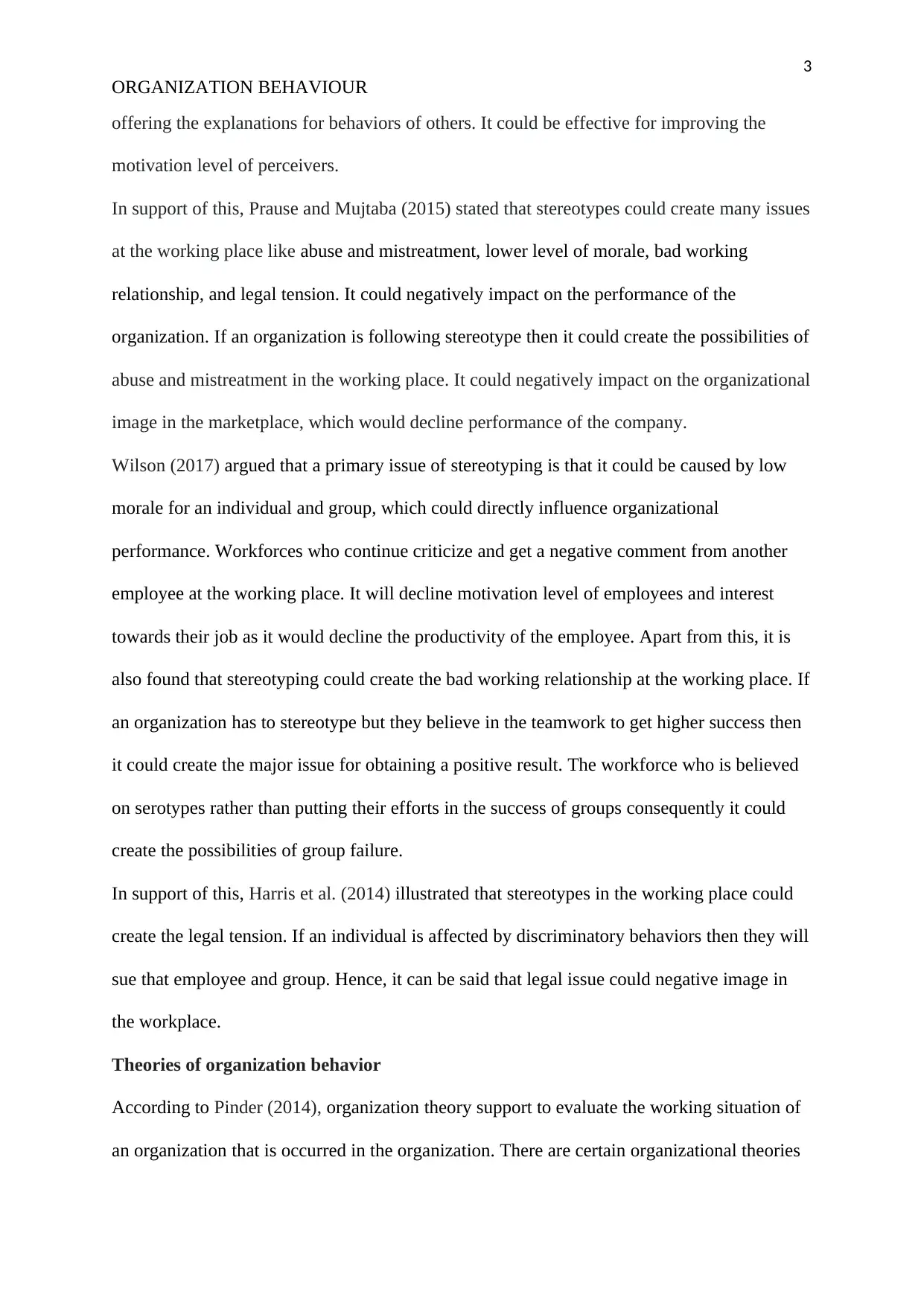
3
ORGANIZATION BEHAVIOUR
offering the explanations for behaviors of others. It could be effective for improving the
motivation level of perceivers.
In support of this, Prause and Mujtaba (2015) stated that stereotypes could create many issues
at the working place like abuse and mistreatment, lower level of morale, bad working
relationship, and legal tension. It could negatively impact on the performance of the
organization. If an organization is following stereotype then it could create the possibilities of
abuse and mistreatment in the working place. It could negatively impact on the organizational
image in the marketplace, which would decline performance of the company.
Wilson (2017) argued that a primary issue of stereotyping is that it could be caused by low
morale for an individual and group, which could directly influence organizational
performance. Workforces who continue criticize and get a negative comment from another
employee at the working place. It will decline motivation level of employees and interest
towards their job as it would decline the productivity of the employee. Apart from this, it is
also found that stereotyping could create the bad working relationship at the working place. If
an organization has to stereotype but they believe in the teamwork to get higher success then
it could create the major issue for obtaining a positive result. The workforce who is believed
on serotypes rather than putting their efforts in the success of groups consequently it could
create the possibilities of group failure.
In support of this, Harris et al. (2014) illustrated that stereotypes in the working place could
create the legal tension. If an individual is affected by discriminatory behaviors then they will
sue that employee and group. Hence, it can be said that legal issue could negative image in
the workplace.
Theories of organization behavior
According to Pinder (2014), organization theory support to evaluate the working situation of
an organization that is occurred in the organization. There are certain organizational theories
ORGANIZATION BEHAVIOUR
offering the explanations for behaviors of others. It could be effective for improving the
motivation level of perceivers.
In support of this, Prause and Mujtaba (2015) stated that stereotypes could create many issues
at the working place like abuse and mistreatment, lower level of morale, bad working
relationship, and legal tension. It could negatively impact on the performance of the
organization. If an organization is following stereotype then it could create the possibilities of
abuse and mistreatment in the working place. It could negatively impact on the organizational
image in the marketplace, which would decline performance of the company.
Wilson (2017) argued that a primary issue of stereotyping is that it could be caused by low
morale for an individual and group, which could directly influence organizational
performance. Workforces who continue criticize and get a negative comment from another
employee at the working place. It will decline motivation level of employees and interest
towards their job as it would decline the productivity of the employee. Apart from this, it is
also found that stereotyping could create the bad working relationship at the working place. If
an organization has to stereotype but they believe in the teamwork to get higher success then
it could create the major issue for obtaining a positive result. The workforce who is believed
on serotypes rather than putting their efforts in the success of groups consequently it could
create the possibilities of group failure.
In support of this, Harris et al. (2014) illustrated that stereotypes in the working place could
create the legal tension. If an individual is affected by discriminatory behaviors then they will
sue that employee and group. Hence, it can be said that legal issue could negative image in
the workplace.
Theories of organization behavior
According to Pinder (2014), organization theory support to evaluate the working situation of
an organization that is occurred in the organization. There are certain organizational theories
⊘ This is a preview!⊘
Do you want full access?
Subscribe today to unlock all pages.

Trusted by 1+ million students worldwide
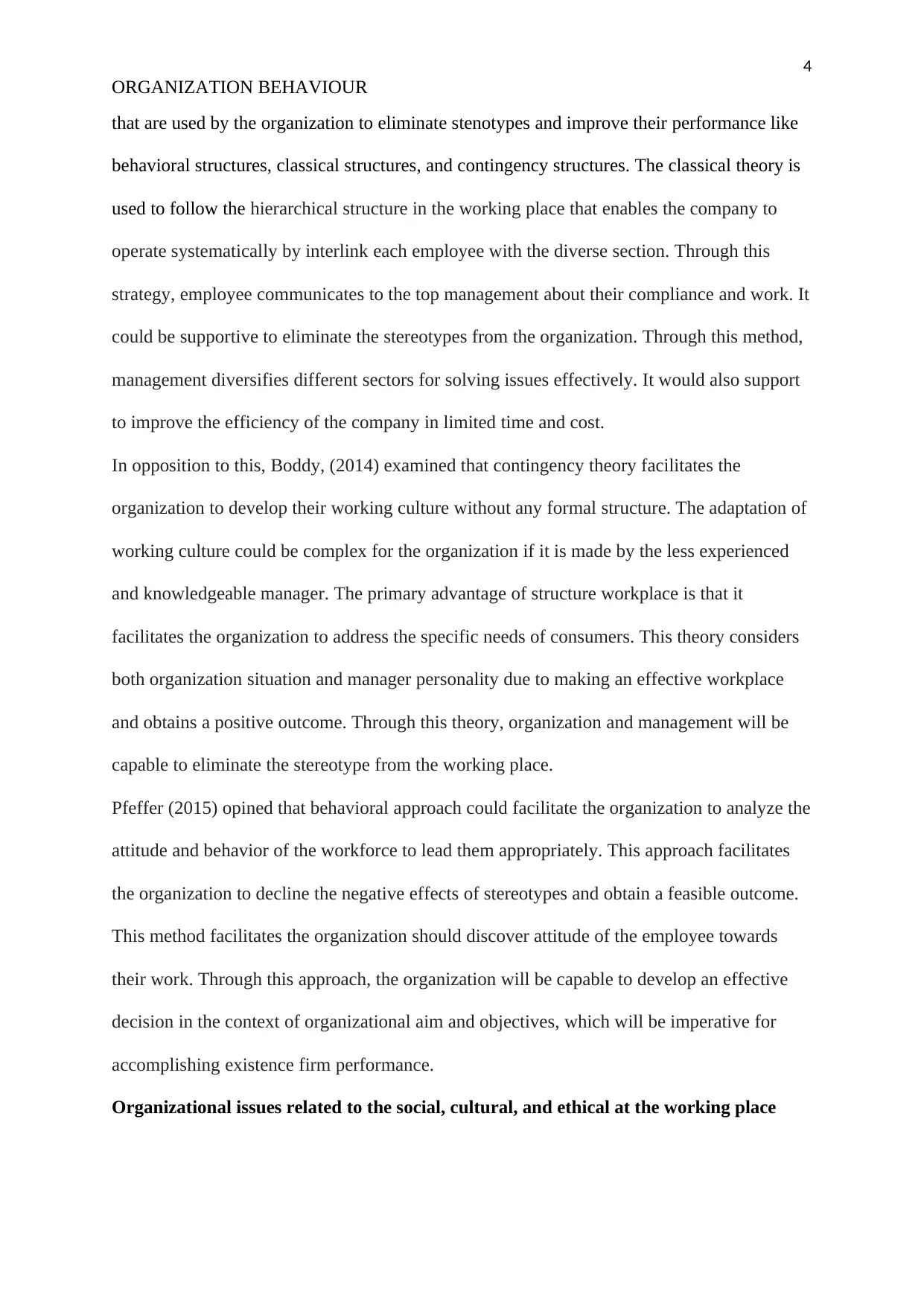
4
ORGANIZATION BEHAVIOUR
that are used by the organization to eliminate stenotypes and improve their performance like
behavioral structures, classical structures, and contingency structures. The classical theory is
used to follow the hierarchical structure in the working place that enables the company to
operate systematically by interlink each employee with the diverse section. Through this
strategy, employee communicates to the top management about their compliance and work. It
could be supportive to eliminate the stereotypes from the organization. Through this method,
management diversifies different sectors for solving issues effectively. It would also support
to improve the efficiency of the company in limited time and cost.
In opposition to this, Boddy, (2014) examined that contingency theory facilitates the
organization to develop their working culture without any formal structure. The adaptation of
working culture could be complex for the organization if it is made by the less experienced
and knowledgeable manager. The primary advantage of structure workplace is that it
facilitates the organization to address the specific needs of consumers. This theory considers
both organization situation and manager personality due to making an effective workplace
and obtains a positive outcome. Through this theory, organization and management will be
capable to eliminate the stereotype from the working place.
Pfeffer (2015) opined that behavioral approach could facilitate the organization to analyze the
attitude and behavior of the workforce to lead them appropriately. This approach facilitates
the organization to decline the negative effects of stereotypes and obtain a feasible outcome.
This method facilitates the organization should discover attitude of the employee towards
their work. Through this approach, the organization will be capable to develop an effective
decision in the context of organizational aim and objectives, which will be imperative for
accomplishing existence firm performance.
Organizational issues related to the social, cultural, and ethical at the working place
ORGANIZATION BEHAVIOUR
that are used by the organization to eliminate stenotypes and improve their performance like
behavioral structures, classical structures, and contingency structures. The classical theory is
used to follow the hierarchical structure in the working place that enables the company to
operate systematically by interlink each employee with the diverse section. Through this
strategy, employee communicates to the top management about their compliance and work. It
could be supportive to eliminate the stereotypes from the organization. Through this method,
management diversifies different sectors for solving issues effectively. It would also support
to improve the efficiency of the company in limited time and cost.
In opposition to this, Boddy, (2014) examined that contingency theory facilitates the
organization to develop their working culture without any formal structure. The adaptation of
working culture could be complex for the organization if it is made by the less experienced
and knowledgeable manager. The primary advantage of structure workplace is that it
facilitates the organization to address the specific needs of consumers. This theory considers
both organization situation and manager personality due to making an effective workplace
and obtains a positive outcome. Through this theory, organization and management will be
capable to eliminate the stereotype from the working place.
Pfeffer (2015) opined that behavioral approach could facilitate the organization to analyze the
attitude and behavior of the workforce to lead them appropriately. This approach facilitates
the organization to decline the negative effects of stereotypes and obtain a feasible outcome.
This method facilitates the organization should discover attitude of the employee towards
their work. Through this approach, the organization will be capable to develop an effective
decision in the context of organizational aim and objectives, which will be imperative for
accomplishing existence firm performance.
Organizational issues related to the social, cultural, and ethical at the working place
Paraphrase This Document
Need a fresh take? Get an instant paraphrase of this document with our AI Paraphraser
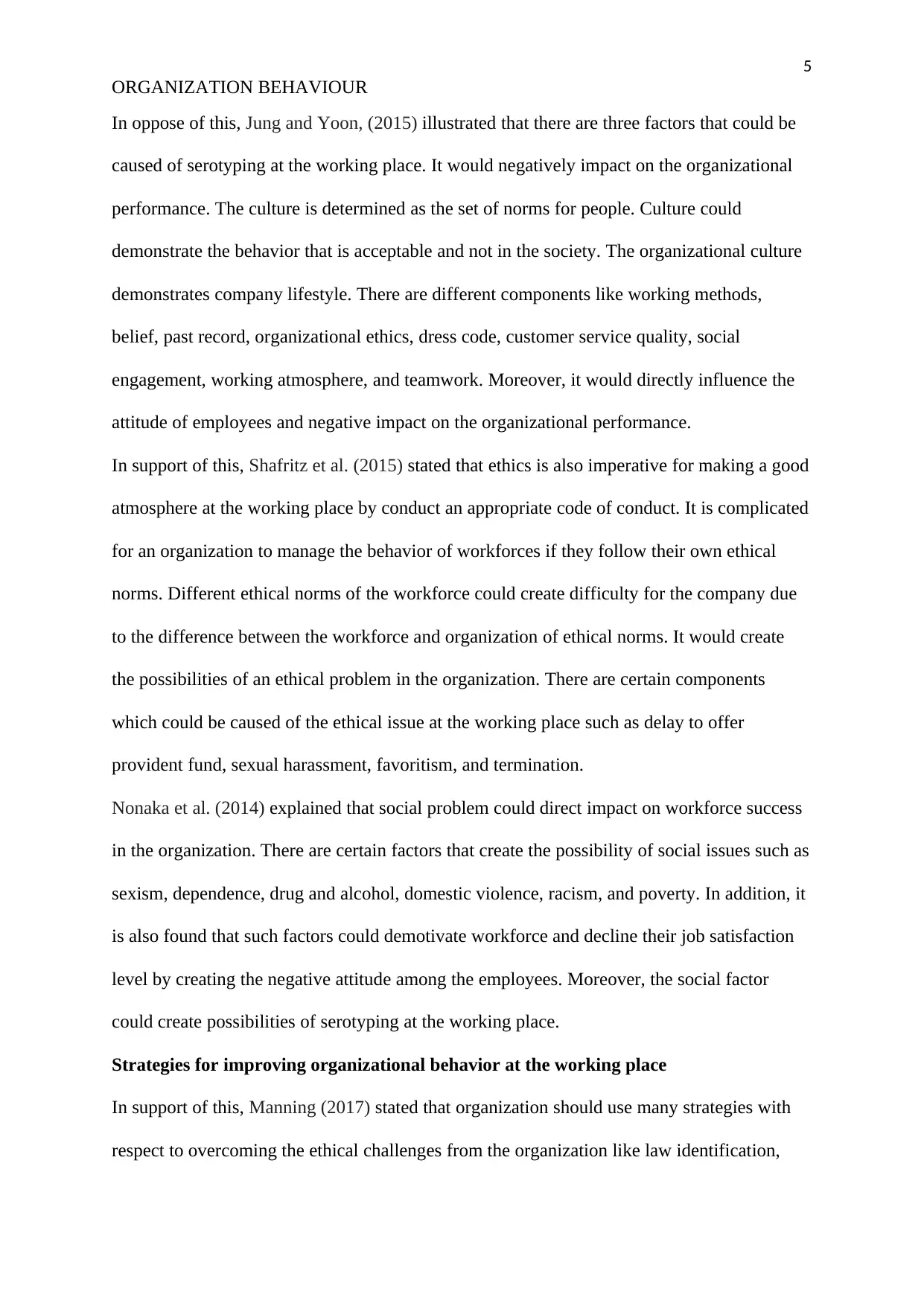
5
ORGANIZATION BEHAVIOUR
In oppose of this, Jung and Yoon, (2015) illustrated that there are three factors that could be
caused of serotyping at the working place. It would negatively impact on the organizational
performance. The culture is determined as the set of norms for people. Culture could
demonstrate the behavior that is acceptable and not in the society. The organizational culture
demonstrates company lifestyle. There are different components like working methods,
belief, past record, organizational ethics, dress code, customer service quality, social
engagement, working atmosphere, and teamwork. Moreover, it would directly influence the
attitude of employees and negative impact on the organizational performance.
In support of this, Shafritz et al. (2015) stated that ethics is also imperative for making a good
atmosphere at the working place by conduct an appropriate code of conduct. It is complicated
for an organization to manage the behavior of workforces if they follow their own ethical
norms. Different ethical norms of the workforce could create difficulty for the company due
to the difference between the workforce and organization of ethical norms. It would create
the possibilities of an ethical problem in the organization. There are certain components
which could be caused of the ethical issue at the working place such as delay to offer
provident fund, sexual harassment, favoritism, and termination.
Nonaka et al. (2014) explained that social problem could direct impact on workforce success
in the organization. There are certain factors that create the possibility of social issues such as
sexism, dependence, drug and alcohol, domestic violence, racism, and poverty. In addition, it
is also found that such factors could demotivate workforce and decline their job satisfaction
level by creating the negative attitude among the employees. Moreover, the social factor
could create possibilities of serotyping at the working place.
Strategies for improving organizational behavior at the working place
In support of this, Manning (2017) stated that organization should use many strategies with
respect to overcoming the ethical challenges from the organization like law identification,
ORGANIZATION BEHAVIOUR
In oppose of this, Jung and Yoon, (2015) illustrated that there are three factors that could be
caused of serotyping at the working place. It would negatively impact on the organizational
performance. The culture is determined as the set of norms for people. Culture could
demonstrate the behavior that is acceptable and not in the society. The organizational culture
demonstrates company lifestyle. There are different components like working methods,
belief, past record, organizational ethics, dress code, customer service quality, social
engagement, working atmosphere, and teamwork. Moreover, it would directly influence the
attitude of employees and negative impact on the organizational performance.
In support of this, Shafritz et al. (2015) stated that ethics is also imperative for making a good
atmosphere at the working place by conduct an appropriate code of conduct. It is complicated
for an organization to manage the behavior of workforces if they follow their own ethical
norms. Different ethical norms of the workforce could create difficulty for the company due
to the difference between the workforce and organization of ethical norms. It would create
the possibilities of an ethical problem in the organization. There are certain components
which could be caused of the ethical issue at the working place such as delay to offer
provident fund, sexual harassment, favoritism, and termination.
Nonaka et al. (2014) explained that social problem could direct impact on workforce success
in the organization. There are certain factors that create the possibility of social issues such as
sexism, dependence, drug and alcohol, domestic violence, racism, and poverty. In addition, it
is also found that such factors could demotivate workforce and decline their job satisfaction
level by creating the negative attitude among the employees. Moreover, the social factor
could create possibilities of serotyping at the working place.
Strategies for improving organizational behavior at the working place
In support of this, Manning (2017) stated that organization should use many strategies with
respect to overcoming the ethical challenges from the organization like law identification,
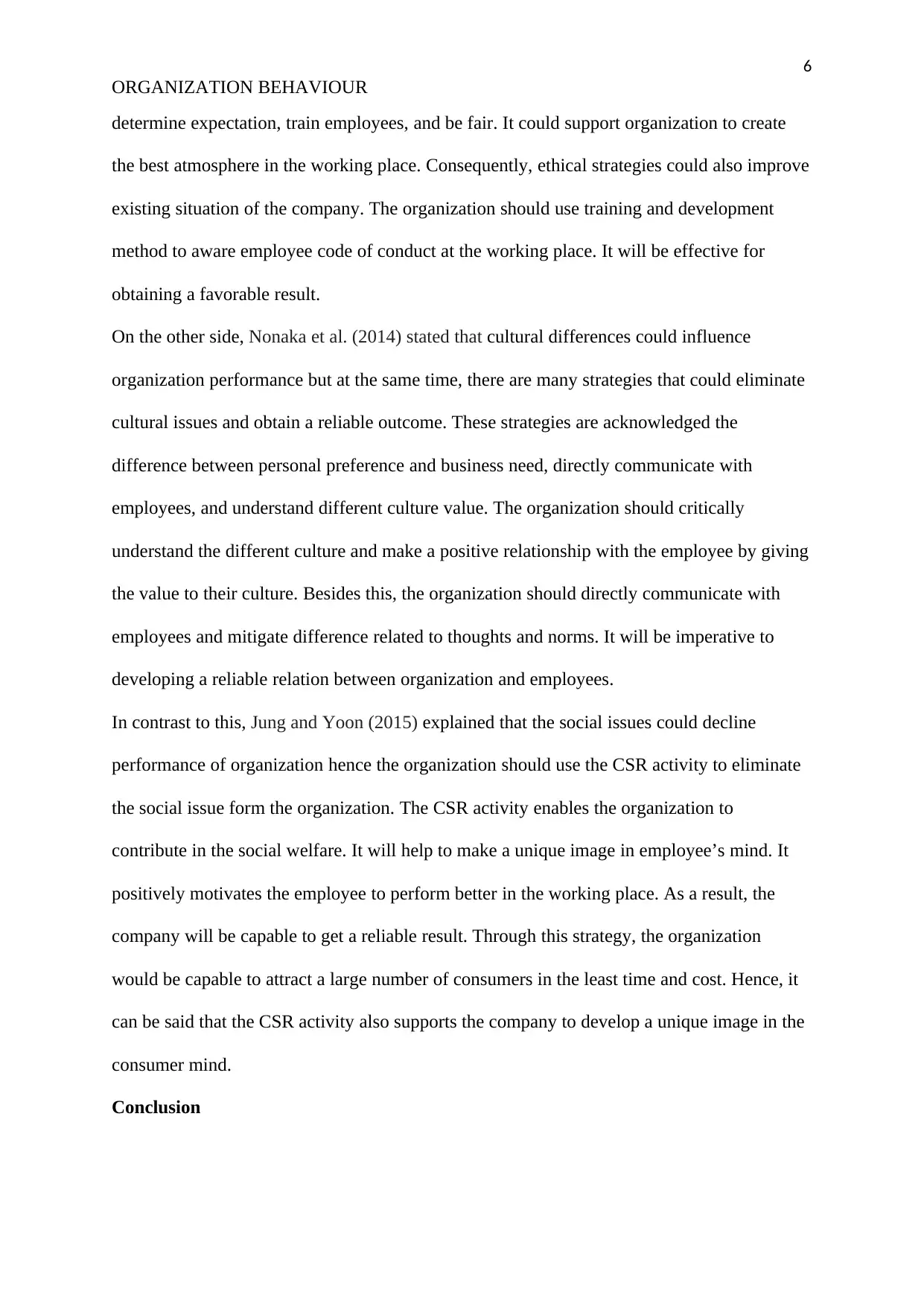
6
ORGANIZATION BEHAVIOUR
determine expectation, train employees, and be fair. It could support organization to create
the best atmosphere in the working place. Consequently, ethical strategies could also improve
existing situation of the company. The organization should use training and development
method to aware employee code of conduct at the working place. It will be effective for
obtaining a favorable result.
On the other side, Nonaka et al. (2014) stated that cultural differences could influence
organization performance but at the same time, there are many strategies that could eliminate
cultural issues and obtain a reliable outcome. These strategies are acknowledged the
difference between personal preference and business need, directly communicate with
employees, and understand different culture value. The organization should critically
understand the different culture and make a positive relationship with the employee by giving
the value to their culture. Besides this, the organization should directly communicate with
employees and mitigate difference related to thoughts and norms. It will be imperative to
developing a reliable relation between organization and employees.
In contrast to this, Jung and Yoon (2015) explained that the social issues could decline
performance of organization hence the organization should use the CSR activity to eliminate
the social issue form the organization. The CSR activity enables the organization to
contribute in the social welfare. It will help to make a unique image in employee’s mind. It
positively motivates the employee to perform better in the working place. As a result, the
company will be capable to get a reliable result. Through this strategy, the organization
would be capable to attract a large number of consumers in the least time and cost. Hence, it
can be said that the CSR activity also supports the company to develop a unique image in the
consumer mind.
Conclusion
ORGANIZATION BEHAVIOUR
determine expectation, train employees, and be fair. It could support organization to create
the best atmosphere in the working place. Consequently, ethical strategies could also improve
existing situation of the company. The organization should use training and development
method to aware employee code of conduct at the working place. It will be effective for
obtaining a favorable result.
On the other side, Nonaka et al. (2014) stated that cultural differences could influence
organization performance but at the same time, there are many strategies that could eliminate
cultural issues and obtain a reliable outcome. These strategies are acknowledged the
difference between personal preference and business need, directly communicate with
employees, and understand different culture value. The organization should critically
understand the different culture and make a positive relationship with the employee by giving
the value to their culture. Besides this, the organization should directly communicate with
employees and mitigate difference related to thoughts and norms. It will be imperative to
developing a reliable relation between organization and employees.
In contrast to this, Jung and Yoon (2015) explained that the social issues could decline
performance of organization hence the organization should use the CSR activity to eliminate
the social issue form the organization. The CSR activity enables the organization to
contribute in the social welfare. It will help to make a unique image in employee’s mind. It
positively motivates the employee to perform better in the working place. As a result, the
company will be capable to get a reliable result. Through this strategy, the organization
would be capable to attract a large number of consumers in the least time and cost. Hence, it
can be said that the CSR activity also supports the company to develop a unique image in the
consumer mind.
Conclusion
⊘ This is a preview!⊘
Do you want full access?
Subscribe today to unlock all pages.

Trusted by 1+ million students worldwide
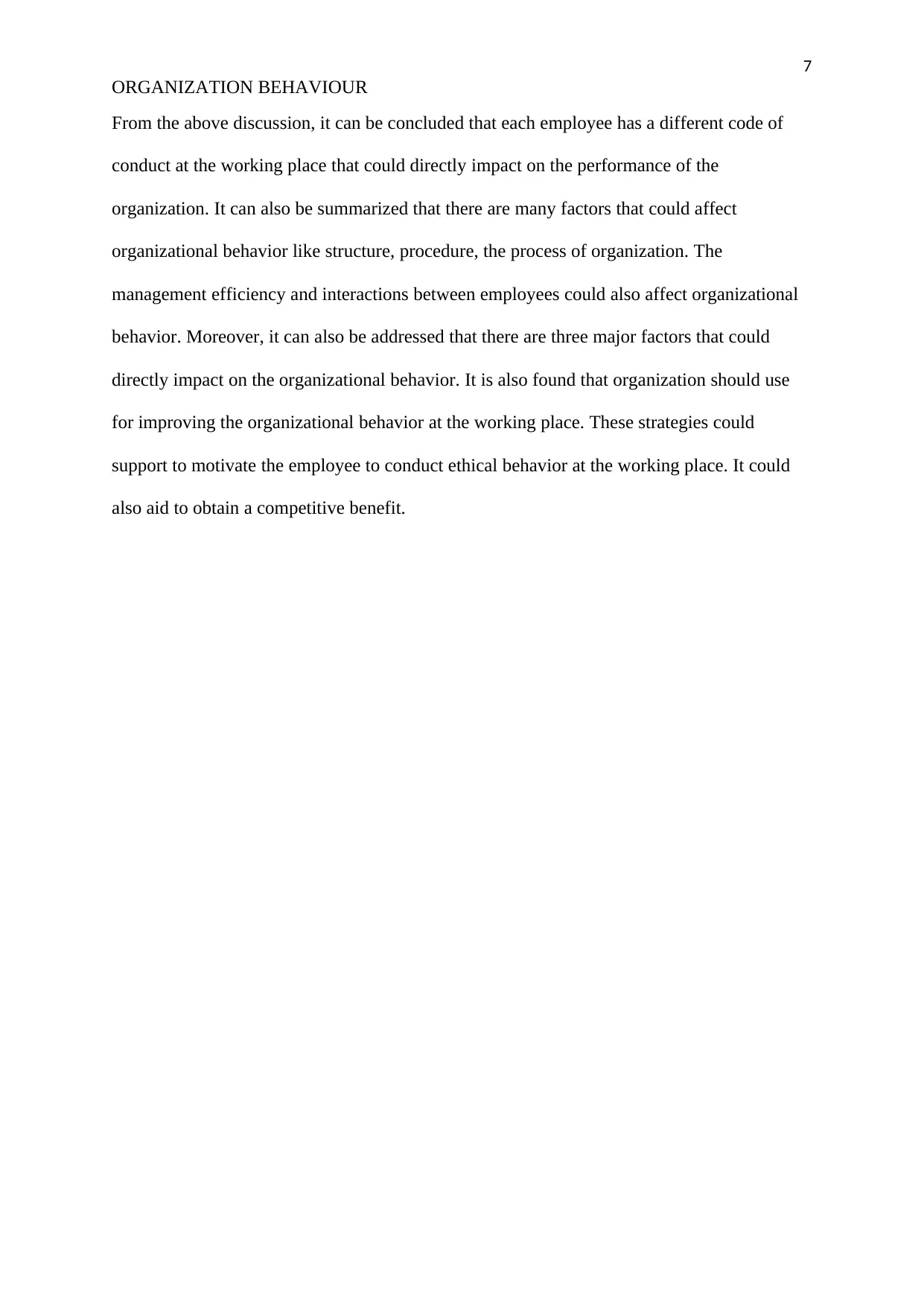
7
ORGANIZATION BEHAVIOUR
From the above discussion, it can be concluded that each employee has a different code of
conduct at the working place that could directly impact on the performance of the
organization. It can also be summarized that there are many factors that could affect
organizational behavior like structure, procedure, the process of organization. The
management efficiency and interactions between employees could also affect organizational
behavior. Moreover, it can also be addressed that there are three major factors that could
directly impact on the organizational behavior. It is also found that organization should use
for improving the organizational behavior at the working place. These strategies could
support to motivate the employee to conduct ethical behavior at the working place. It could
also aid to obtain a competitive benefit.
ORGANIZATION BEHAVIOUR
From the above discussion, it can be concluded that each employee has a different code of
conduct at the working place that could directly impact on the performance of the
organization. It can also be summarized that there are many factors that could affect
organizational behavior like structure, procedure, the process of organization. The
management efficiency and interactions between employees could also affect organizational
behavior. Moreover, it can also be addressed that there are three major factors that could
directly impact on the organizational behavior. It is also found that organization should use
for improving the organizational behavior at the working place. These strategies could
support to motivate the employee to conduct ethical behavior at the working place. It could
also aid to obtain a competitive benefit.
Paraphrase This Document
Need a fresh take? Get an instant paraphrase of this document with our AI Paraphraser
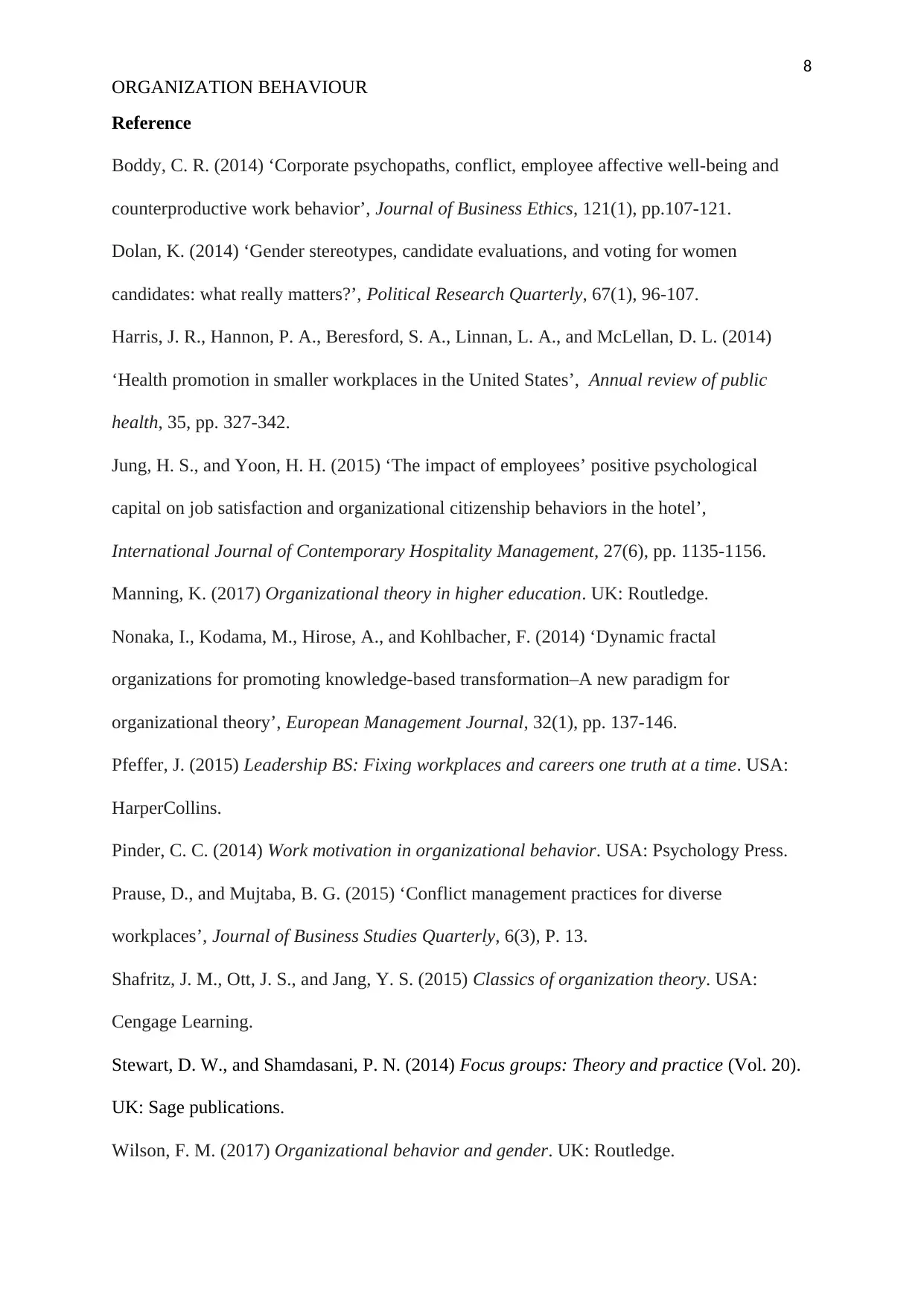
8
ORGANIZATION BEHAVIOUR
Reference
Boddy, C. R. (2014) ‘Corporate psychopaths, conflict, employee affective well-being and
counterproductive work behavior’, Journal of Business Ethics, 121(1), pp.107-121.
Dolan, K. (2014) ‘Gender stereotypes, candidate evaluations, and voting for women
candidates: what really matters?’, Political Research Quarterly, 67(1), 96-107.
Harris, J. R., Hannon, P. A., Beresford, S. A., Linnan, L. A., and McLellan, D. L. (2014)
‘Health promotion in smaller workplaces in the United States’, Annual review of public
health, 35, pp. 327-342.
Jung, H. S., and Yoon, H. H. (2015) ‘The impact of employees’ positive psychological
capital on job satisfaction and organizational citizenship behaviors in the hotel’,
International Journal of Contemporary Hospitality Management, 27(6), pp. 1135-1156.
Manning, K. (2017) Organizational theory in higher education. UK: Routledge.
Nonaka, I., Kodama, M., Hirose, A., and Kohlbacher, F. (2014) ‘Dynamic fractal
organizations for promoting knowledge-based transformation–A new paradigm for
organizational theory’, European Management Journal, 32(1), pp. 137-146.
Pfeffer, J. (2015) Leadership BS: Fixing workplaces and careers one truth at a time. USA:
HarperCollins.
Pinder, C. C. (2014) Work motivation in organizational behavior. USA: Psychology Press.
Prause, D., and Mujtaba, B. G. (2015) ‘Conflict management practices for diverse
workplaces’, Journal of Business Studies Quarterly, 6(3), P. 13.
Shafritz, J. M., Ott, J. S., and Jang, Y. S. (2015) Classics of organization theory. USA:
Cengage Learning.
Stewart, D. W., and Shamdasani, P. N. (2014) Focus groups: Theory and practice (Vol. 20).
UK: Sage publications.
Wilson, F. M. (2017) Organizational behavior and gender. UK: Routledge.
ORGANIZATION BEHAVIOUR
Reference
Boddy, C. R. (2014) ‘Corporate psychopaths, conflict, employee affective well-being and
counterproductive work behavior’, Journal of Business Ethics, 121(1), pp.107-121.
Dolan, K. (2014) ‘Gender stereotypes, candidate evaluations, and voting for women
candidates: what really matters?’, Political Research Quarterly, 67(1), 96-107.
Harris, J. R., Hannon, P. A., Beresford, S. A., Linnan, L. A., and McLellan, D. L. (2014)
‘Health promotion in smaller workplaces in the United States’, Annual review of public
health, 35, pp. 327-342.
Jung, H. S., and Yoon, H. H. (2015) ‘The impact of employees’ positive psychological
capital on job satisfaction and organizational citizenship behaviors in the hotel’,
International Journal of Contemporary Hospitality Management, 27(6), pp. 1135-1156.
Manning, K. (2017) Organizational theory in higher education. UK: Routledge.
Nonaka, I., Kodama, M., Hirose, A., and Kohlbacher, F. (2014) ‘Dynamic fractal
organizations for promoting knowledge-based transformation–A new paradigm for
organizational theory’, European Management Journal, 32(1), pp. 137-146.
Pfeffer, J. (2015) Leadership BS: Fixing workplaces and careers one truth at a time. USA:
HarperCollins.
Pinder, C. C. (2014) Work motivation in organizational behavior. USA: Psychology Press.
Prause, D., and Mujtaba, B. G. (2015) ‘Conflict management practices for diverse
workplaces’, Journal of Business Studies Quarterly, 6(3), P. 13.
Shafritz, J. M., Ott, J. S., and Jang, Y. S. (2015) Classics of organization theory. USA:
Cengage Learning.
Stewart, D. W., and Shamdasani, P. N. (2014) Focus groups: Theory and practice (Vol. 20).
UK: Sage publications.
Wilson, F. M. (2017) Organizational behavior and gender. UK: Routledge.
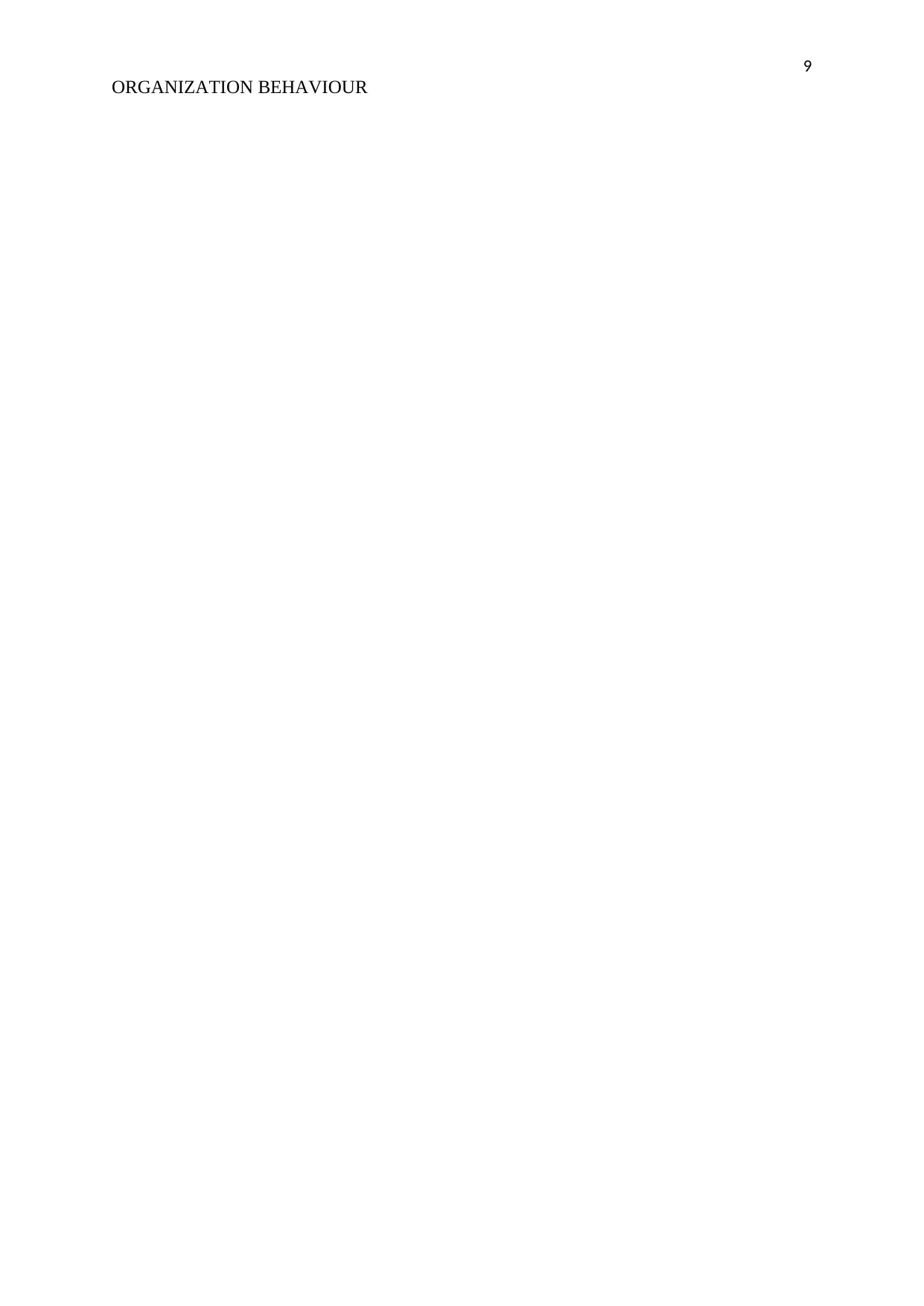
9
ORGANIZATION BEHAVIOUR
ORGANIZATION BEHAVIOUR
⊘ This is a preview!⊘
Do you want full access?
Subscribe today to unlock all pages.

Trusted by 1+ million students worldwide
1 out of 9
Related Documents
Your All-in-One AI-Powered Toolkit for Academic Success.
+13062052269
info@desklib.com
Available 24*7 on WhatsApp / Email
![[object Object]](/_next/static/media/star-bottom.7253800d.svg)
Unlock your academic potential
Copyright © 2020–2025 A2Z Services. All Rights Reserved. Developed and managed by ZUCOL.





